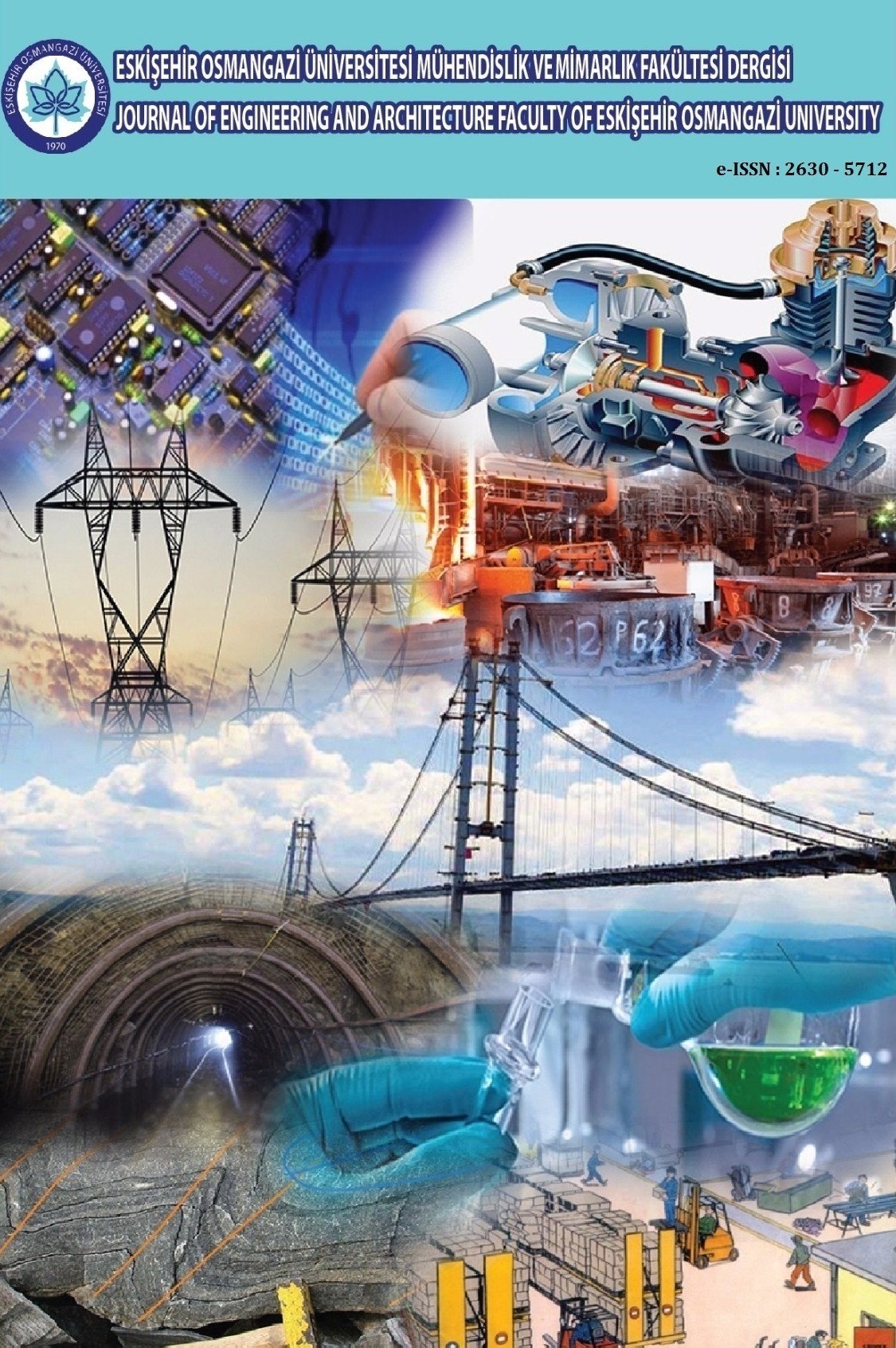Yapay Sinir Ağı Yaklaşımı İle Tornalamada Yüzey Pürüzlülüğünün Tahmin Edilmesi
Takım Geometrisi, Yüzey Pürüzlülüğü, Yapay Sinir Ağları.
Prediction Of Surface Roughness On Turning With Artificial Neural Network
Tool geometry, Surface Roughness, Artificial Neural Network.,
___
- [1] Y. Işık, M.C. Çakır, “Hız Çeliği Takımlar İçin Kesme Parametrelerinin Yüzey Pürüzlülüğüne Etkilerinin Deneysel Olarak İncelenmesi”, Teknoloji Dergisi, Sayı 1-2, ss. 111-118, 2001.
- [2] Ş. Taşdemir, S. Neşeli, İ. Sarıtaş, S. Yaldız, “Prediction of surface roughness using artificial neural network in Lathe”, CompSysTech’08, Gabrovo, Bulgaristan, 2008.
- [3] P.G. Benardos, G.C. Vosniakos, “Predicting surface roughness in machining: a review”, Int. J. Mach. Tools Manuf. 43, pp. 833–844, 2003.
- [4] G.P. Petropoulos, N.M. Vaxevanidis, C.N. Pandazaras, A.A. Antoniadis, “Multi-parameter identification and control of turned surface textures”, Int. J. Adv. Manuf. Technol, Vol. 29, pp. 118–128, 2006.
- [5] G. Boothroyd, W.A. Knight, “Fundamentals of Machining and Machine Tools”, Marcel Dekker, New York, 1989.
- [6] A.E. Diniz, R. Micaroni, “Cutting conditions for finish turning process aiming: the use of dry cutting”, Int. J. Mach. Tools Manuf., pp. 432, 899–904, 2002.
- [7] N. Allahverdi, “Uzman Sistemler, Bir Yapay Zeka Uygulaması”, Atlas Yayın Dağıtım, İstanbul, 2002.
- [8] E. Öztemel, “Yapay Sinir Ağları”, Papatya Yayıncılık, İstanbul, 2003.
- [9] S. Tasdemir, I. Saritas, M. Ciniviz, C. Cinar ve N. Allahverdi, “Application of artificial neural network for definition of a gasoline engine performance”, 4th International Advanced Technologies Symposium, Konya, Turkey, pp. 1030-1034, 28-30 Sept, 2005.
- [10] N.R. Abburi, U.S. Dixit, “A knowledge-based system for the prediction of surface roughness in turning process”, Rob. Comp. Integr. Manuf., Vol. 22, pp. 363–372, 2006.
- [11] T. Erzurumlu, H. Oktem, “Comparison of response surface model with neural network in determining the surface quality of moulded parts”, Mater. Des., Vol. 28, pp. 459–465, 2007.
- [12] J. Paulo Davim, V.N. Gaitonde, S.R. Karnik, “Investigations into the effect of cutting conditions on surface roughness in turning of free machining steel by ANN models”, Journal of Materials Processing Technology, Vol. 205, pp. 16–23, 2008.
- [13] C. Lu, “Study on prediction of surface quality in machining process”, Journal of Materials Processing Technology, Vol. 205, 439–450, 2008.
- [14] S. Neşeli, S. Yaldız, “Tornalamada Yaklaşma Açısı ve Talaş Açısına Bağlı Tırlama Titreşimlerinin Yüzey Pürüzlülüğüne Etkileri”, Politeknik Dergisi, Cilt.10, Sayı. 4, ss.219- 227, 2007.
- [15] M.A. Akçayol, C. Çınar, H.İ. Bülbül ve A. Kılıçarslan, “Artificial neural network based modeling of injection pressure in diesel engines”, World Scientific and Engineering Academy and Society (WSEAS) Transactions on Computers, ISSN 1109-2750, 3(5), pp. 1538-1544, 2004.
- [16] A. Şencan, “Artificial intelligent methods for thermodynamic evaluation of ammonia–water refrigeration systems”, Energy Conversion and Management, Vol. 47, pp. 3319-3332, 2006.
- [17] G. Scalabrin, M. Condosta ve P. Marchi, “Mixtures flow boiling: modeling heat transfer through artificial neural Networks”, International Journal of Thermal Sciences, Vol. 45, No. 7, pp. 664-680, 2006.
- [18] Y. Islamoglu ve A. Kurt, “Heat transfer analysis using ANNs with experimental data for air flowing in corrugated channels”, International Journal of Heat and Mass Transfer, 47, pp. 1361-1365, 2004.
- [19] C.S. Lee, W. Hwang,, H.C. Park ve K.S. Han, “Failure of carbon/epoxy composite tubes under combined axial and torsional loading 1. Experimental results and prediction of biaxial strength by the use of neural networks”, Composites Science and Technology, Vol. 59, No. 12, pp. 779-1788, 1999.
- Yayın Aralığı: Yılda 3 Sayı
- Başlangıç: 1986
- Yayıncı: Eskişehir Osmangazi Üniversitesi
Baraj Göllerinde Deprem Sırasında Oluşan Hidrodinamik Basınçların Sayısal Benzetimi
Serkan SUBAŞI, Ahmet BEYCİOĞLU, Mehmet EMİROĞLU
Kaynatılmış Buğdayın Akışkan Yatakta Kurutulmasının Deneysel Araştırılması
Ümran ERÇETİN, İ. Yalçın URALCAN
Metalik Toz İşleme Teknolojisi Ve Prosesleme Kademeleri Açısından Parametrik İlişkiler
Şadi KARAGÖZ, Rıdvan YAMANOĞLU, Ş. Hakan ATAPEK
Kimyasal Etkide Kalmış AAYFC’li Harcın Dayanımının YSA Ve BM Kullanılarak Tahmini
İlker Bekir TOPÇU, Mehmet CANBAZ, Mustafa SARIDEMİR
Farklı Puzolanlarla Üretilmiş Çimentoların Dayanım Gelişiminin Yapay Sinir Ağlarıyla Tahmini
İlker Bekir TOPÇU, Cenk KARAKURT, Mustafa SARIDEMİR
Isısal Etkide Kalmış AAYFC’li Harcın Dayanımının YSA Ve BM Kullanılarak Tahmini
İlker Bekir TOPÇU, Mehmet CANBAZ, Mustafa SARIDEMİR
Serkan SUBAŞI, Ahmet BEYCİOĞLU, Mehmet EMİROĞLU
Elektrik Enerji Dağıtım Sisteminde Ekonomik Aktif Güç Dağıtımının Genetik Algoritma İle Belirlenmesi
